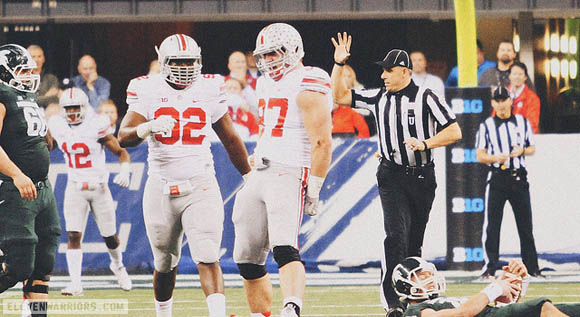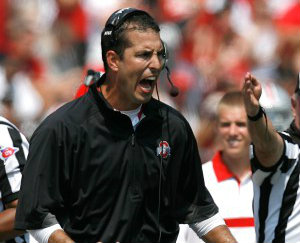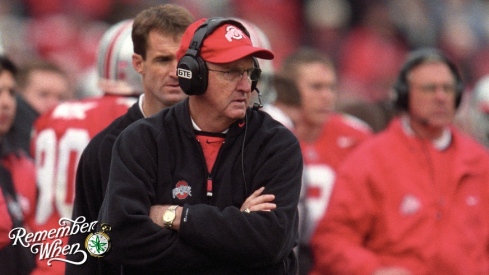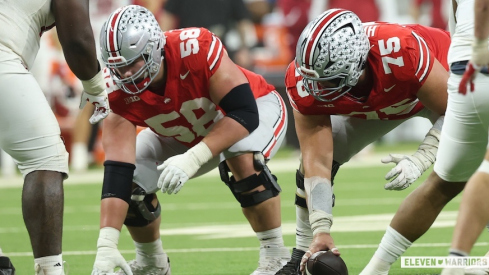
To the Booth is typically reserved for previewing the numbers behind the upcoming Saturday's matchup. However, we're still a ways off from our battle with Clemson, so we have plenty of time to dissect this year's team.
Up first is the team's biggest weakness: the defense. Even the most pessimistic Buckeyes were probably surprised by the defensive performance in the Big Ten Championship game. A regular season's worth of data contained little if anything to suggest that the Buckeye defense would be punished as badly as it was.
Here are some highlights from the statistical preview:
My only real concern about the Michigan State offense – the one led by Mr. Bollman – is an overabundance of running back screens on passing downs against over-pursuing defenders.
Michigan State's offense is not really built to create explosive plays, nor does it average a high number of plays per drive.
Instead, the defense allowed .436 points per play and six explosive plays. That was the first time all season that the Buckeyes did not win the explosive play margin and had a lower points per play than their opponent. Furthermore, Ohio State's defense – which courteously allowed Langford to become its first opposing 100-yard rusher on the season – had consistently held opponents below their season averages in rushing yards.
I don't rehash the game to depress you or to pile on an already beleaguered unit, but instead to emphasize the limitations of our data each year and to suggest an even deeper look into the statistical roots of our defensive problems.
Towards that end, we'll break down two commonly cited Football Outsiders' metrics – the S&P+ and the FEI – for all of their components. Both are composite metrics, containing a series of opponent-adjusted measures of efficiency and explosiveness that are then combined to give a single number and rank for each team.
S&P+ Data
| S&P+ | Play Eff | Std Downs | Pass Downs | Rushing | Passing | Drive EFF | DNP | |
|---|---|---|---|---|---|---|---|---|
| OSU Def | 112.2 (40) | 102.9 (52) | 102 (64) | 106.9 (49) | 110.2 (37) | 102.2 (59) | 121.5 (33) | -1.53 (8) |
The basic S&P+ component is comprised of a play's success rate (like the running back success rate, it measures whether a play advances a certain number of yards towards a first down), a measure of points per play that places an expected number of points an offense might gain at each yard line, and a measure of drive efficiency (which takes field position and an offense's ability to score points from a given field position).
In the table above then, we have the overall S&P+, the individual measure of play efficiency, and then the S&P+ scores for standard down, passing down, rushing plays, and passing plays, the measure of drive efficiency, and finally a difference in net points measure, which is the "raw average of the points an offense scores on a given drive compared to the points it would be expected to score based on starting field position." The numbers in parentheses are the ranking. Obviously, that's a heck of a lot of information.
- The thing that first jumps out to me is that the Buckeyes are ranked lower on standard downs S&P+ than on passing downs S&P+. Especially considering that the Buckeyes passing S&P+ is significantly worse than the rushing, this indicates that opposing offenses are comfortable throwing the ball against the Buckeye defense on standard downs (standard downs are all first downs, second down with less than eight yards to go, and third or fourth down with less than five to go).
- Despite opposing defenses' success on standard downs, the Buckeyes are far better against the run than against the pass (obviously). However, what's interesting to me is that this unit, despite just now allowing a 100 yard rusher, is not in the elite group of rushing S&P+ defenses (with MSU, Alabama, Virginia Tech, and Utah State).
- Our S&P+ peers are Rice, Houston, Tulane, and Duke. Remember that these metrics are adjusted by strength of schedule, compared "to the expected output based upon their opponents and their opponents' opponents. This is a schedule-based adjustment designed to reward tougher schedules and punish weaker ones."
- Where the Buckeyes really are elite, however, is in the difference in net points metric. Essentially, this implies that the Buckeyes do a great job beating expectations for how many points an opposing offense is expected to score given a particular starting field position. DNP is the only category that MSU, Virginia Tech, USC, and Stanford (all top seven overall) do not rank in the top fifteen in.
My primary takeaway is that the Buckeyes must improve specifically against the pass on standard downs. Opponents are comfortable throwing the ball short distances (second and five, third and three) as well as on first down. They are less successful – again relative to other defenses and adjusted by opponents schedules – getting yards on actual passing downs. This suggests to me (though the numbers alone cannot confirm it) that a major part of the issue is scheme.
We know that coverage breakdowns are certainly the result of personnel problems (mainly young players and backups receiving significant playing time), mental lapses, and miscommunications, but the numbers above are symptomatic of structural issues as well. There is a clear difference between the defense on passing downs and standard downs, and against the pass versus the run.
FEI Data
| DFEI | DE | FD | AY | EX | ME | VA | DSOS PVS | DSOS FUT | |
|---|---|---|---|---|---|---|---|---|---|
| OSU Def | -.217 (36) | -.086 (53) | .638 (36) | .406 (31) | .134 (68) | .157 (80) | .342 (35) | .158 (64) | .720 (27) |
Brian Fremeau's FEI is a possession-based composite measure of efficiency and explosiveness, that uses nine opponent-adjusted metrics of efficiency and explosiveness.
DFEI is the overall measure of opponent-adjusted efficiency, while DE is the raw unadjusted measure of drive success against expected drive success considering opposing field position. FD stands for first down rate (percentage of drives that result in at least one first down), and AY is short for available yards (opponent yards divided by total number of yards considering field position).
 Can Fickell and Withers clean up the defense for Clemson?
Can Fickell and Withers clean up the defense for Clemson?EX is the percentage of opposing drives that average at least ten yards per play, ME tracks methodological drives (ten or more plays), VA considers drives that begin on an opponent's own side of the field and end on at least the defense's 30 yard line, and finally, the two DSOS measures consider the likelihood that an elite defense (two standard deviations above average) would have an above-average defensive efficiency (DE) against each of the offenses faced (PVS, or previous), or will face (FUT, or future).
- The Buckeyes are ranked in the mid-thirties on many of the FEI components, including overall, defensive efficiency, first down rate, available yards, and value drives. This matches up well with how we might judge the defense with just our eyes.
- While mid-30s is unacceptable, where the Buckeyes really struggle according to the FEI are in explosive drives and methodological drives. That is, the Buckeyes too often allow drives that average at least ten yards per play while also too-frequently allowing long drives of 10+ plays. What's really interesting here is that the Buckeyes are actually fairly excellent at preventing explosive plays of 20+ yards (tied for 16th overall), but much worse (43rd) at preventing explosive plays of 10+ yards. Opponents attack for intermediate gains (quick screens, curls and outs on soft coverage, and short crossing routes) rather than long touchdown breakdowns for the most part.
- Just a little more on the low ranking for methodological drives – Ohio State is fairly good at opponent third down conversion rate, so the problem again lies in opponents picking up first downs on standard downs, before even forcing a third down conversion attempt. In particular, the Buckeyes are fairly poor on second down, when opposing quarterback completion percentage spikes.
- Some room for optimism might be that the DSOS FUT, or future defensive strength of schedule, is the highest ranked component for the DFEI. With Clemson as the only opponent remaining for the Buckeyes, perhaps that suggests an elite defense could have an above-average performance against the Tigers. We know Chad Morris and the Tigers can be stopped (see: Florida State), but the question is whether the Buckeyes can scheme effectively and coach the secondary into taking better angles against Boyd's fearsome passing attack.
There is no easy answer for the Buckeye defense according to statistics alone, though the advanced numbers certainly reflect the mediocre performances we see each Saturday. However, there is ample evidence that the problems are, at least to a degree, consistent and structural.
That absolutely does not mean that coaches need to be fired, but it does make me question the limited development over the course of the season. It's possible that the defensive coordinators simply believe that the changes we suggest as a fan base (rotating in younger personnel, playing tighter coverages, calling more aggressive plays) would result in even worse outcomes than the current status quo.
However, with fifteen practices between a date with the Tigers, the coaches have ample time to refine coverages and play calls to maximize personnel growth and set up the defense on a better trajectory for next season.

